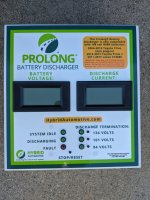I wanted to follow up on this, as it has been a while. I wound up buying new batteries after nursing my old ones around for another 10,000 miles or so on the Prolong system. So, ultimately, not a very good deal, and a lot of time spent reconditioning.
Every battery pack will age differently, so I'm sure that my experiences will differ from many others. The short-term benefit (really good, up to 54 mpg best case - no traffic, no AC, no highway) of full reconditioning (charge/discharge/charge cycles) seemed to last only around 100 to 200 miles on my battery pack. Then, it would settle down to 50-ish mpg (best case) for the next 1000-2000 miles or so (let's call this an intermediate benefit). Then it would drop again to the mid 46-48 range (best case).
After some experimenting, that intermediate benefit seemed to come from the rebalancing phase alone (just extended charging), so that's what I wound up doing over and over. Saved a lot of time, but it was still time consuming. Again, a particularity of my battery pack, probably.
At any rate, I'm getting 56 mpg best case with the new batteries. A side benefit is that there is much less brake dust on my wheels now due to more effective regenerative braking.



